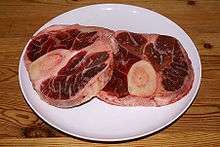Ossobuco
 | |
| Type | Casserole |
|---|---|
| Place of origin | Italy |
| Main ingredients | cross-cut veal shanks braised with vegetables, white wine and broth. |
| Variations | ossobuco in bianco |
| 100 kcal (419 kJ) | |
Ossobuco or osso buco (pronounced [ˌɔssoˈbuːko]; Milanese: òss bus [ˌɔzˈbyːs]) is a specialty of Lombard cuisine of cross-cut veal shanks braised with vegetables, white wine and broth. It is often garnished with gremolata and traditionally served with either risotto alla milanese or polenta, depending on the regional variation. The marrow in the hole in the bone, a prized delicacy, is the defining feature of the dish.[1][2]
There are two types of ossobuco: a modern version that has tomatoes and the original version which does not. The older version, ossobuco in bianco, is flavoured with cinnamon, bay leaf and gremolata. The modern and more popular recipe includes tomatoes, carrots, celery and onions; gremolata is optional. While veal is the traditional meat used for ossobuco, dishes with other meats such as pork have been called ossobuco.[3]
Name

Ossobuco or osso buco is Italian for "bone with a hole" (osso "bone", buco "hole"), a reference to the marrow hole at the centre of the cross-cut veal shank. In the local Western Lombard Milanese dialect, this dish's name is òss bus.[1][4]
Preparation

This dish's primary ingredient, veal shank, is common, relatively cheap and flavorful. Although tough, braising makes it tender. The cut traditionally used for this dish comes from the top of the shin which has a higher proportion of bone to meat than other meaty cuts of veal.[5] The shank is then cross-cut into sections about 3 cm thick.[6]
Although recipes vary, most start by browning the veal shanks in butter after dredging them in flour, while others recommend vegetable oil or lard.[7] The braising liquid is usually a combination of white wine and meat broth flavored with vegetables.[8]
Accompaniments
Risotto alla milanese is the traditional accompaniment to ossobuco in bianco, making for a one-dish meal.[6] Ossobuco (especially the tomato-based version) is also eaten with polenta or mashed potatoes.[9] Outside Milan, it is sometimes served with pasta.[7]
See also
References
- 1 2 "osso buco". Oxford English Dictionary (3rd ed.). Oxford University Press. September 2005. (Subscription or UK public library membership required.)
- ↑ Felicity Cloake (6 March 2014). "How to cook the perfect osso buco". The Guardian. Retrieved 2 October 2018. Article comparing several variants of the recipe.
- ↑ Mark Hix (15 February 2016). "Recipe: Pork osso bucco". The Independent. Retrieved 2 October 2018.
- ↑ Francesco Angiolini, Vocabolario milanese-italiano coi segni per la pronuncia, 1897 oss bus
- ↑ Cuts of veal as displayed on Merriam-Webster.com
- 1 2 Touring Club Italiano, Guida all'Italia gastronomica, 1984, p. 207
- 1 2 Waverley Root, The Food of Italy, 1971, p. 272
- ↑ Giada De Laurentiis' recipe for ossobuco on the Food Network website
- ↑ Clifford A. Wright on ossobuco